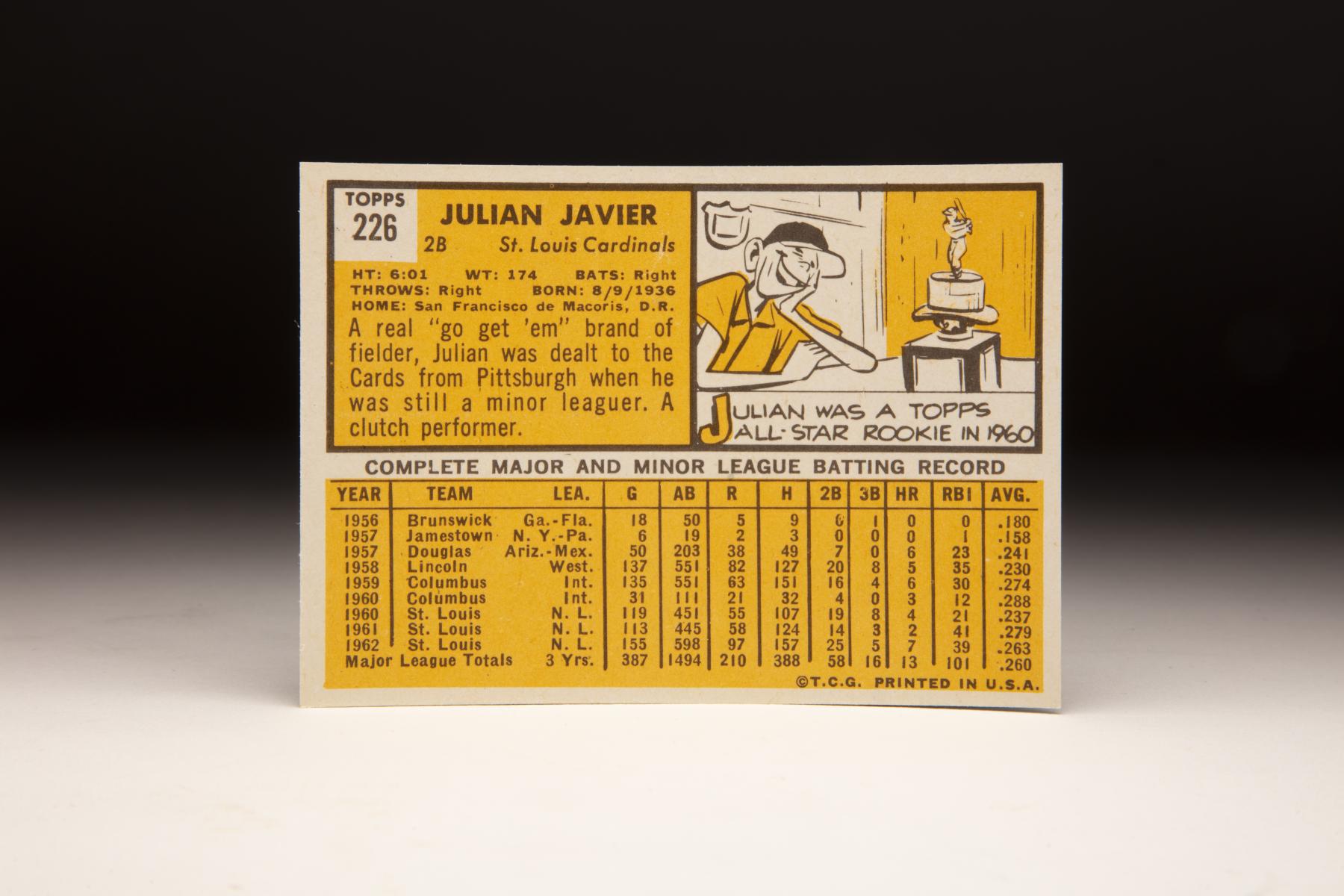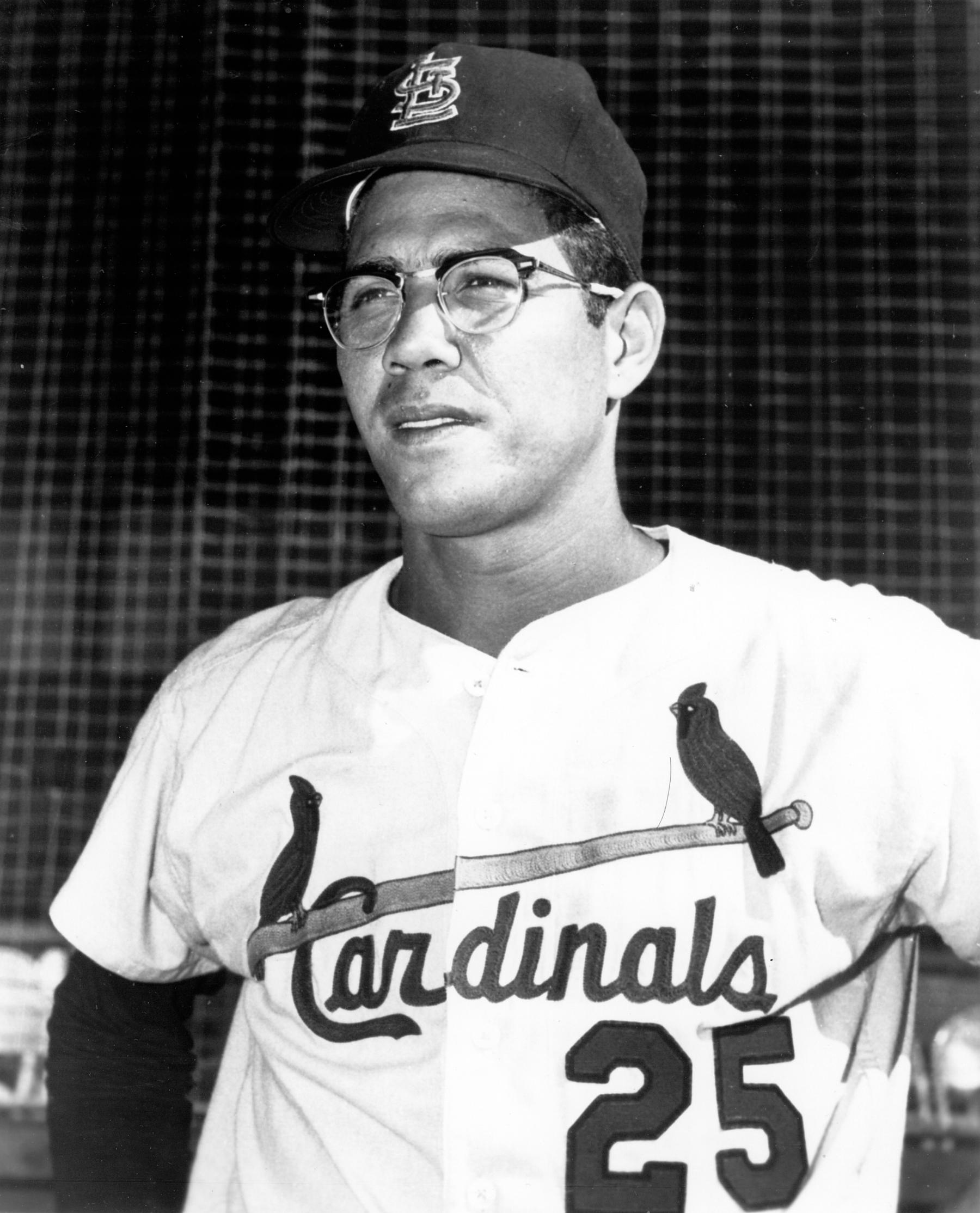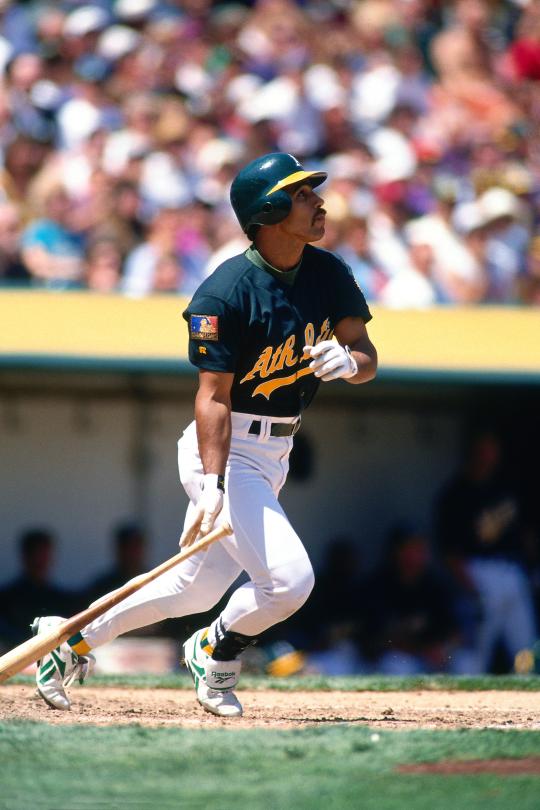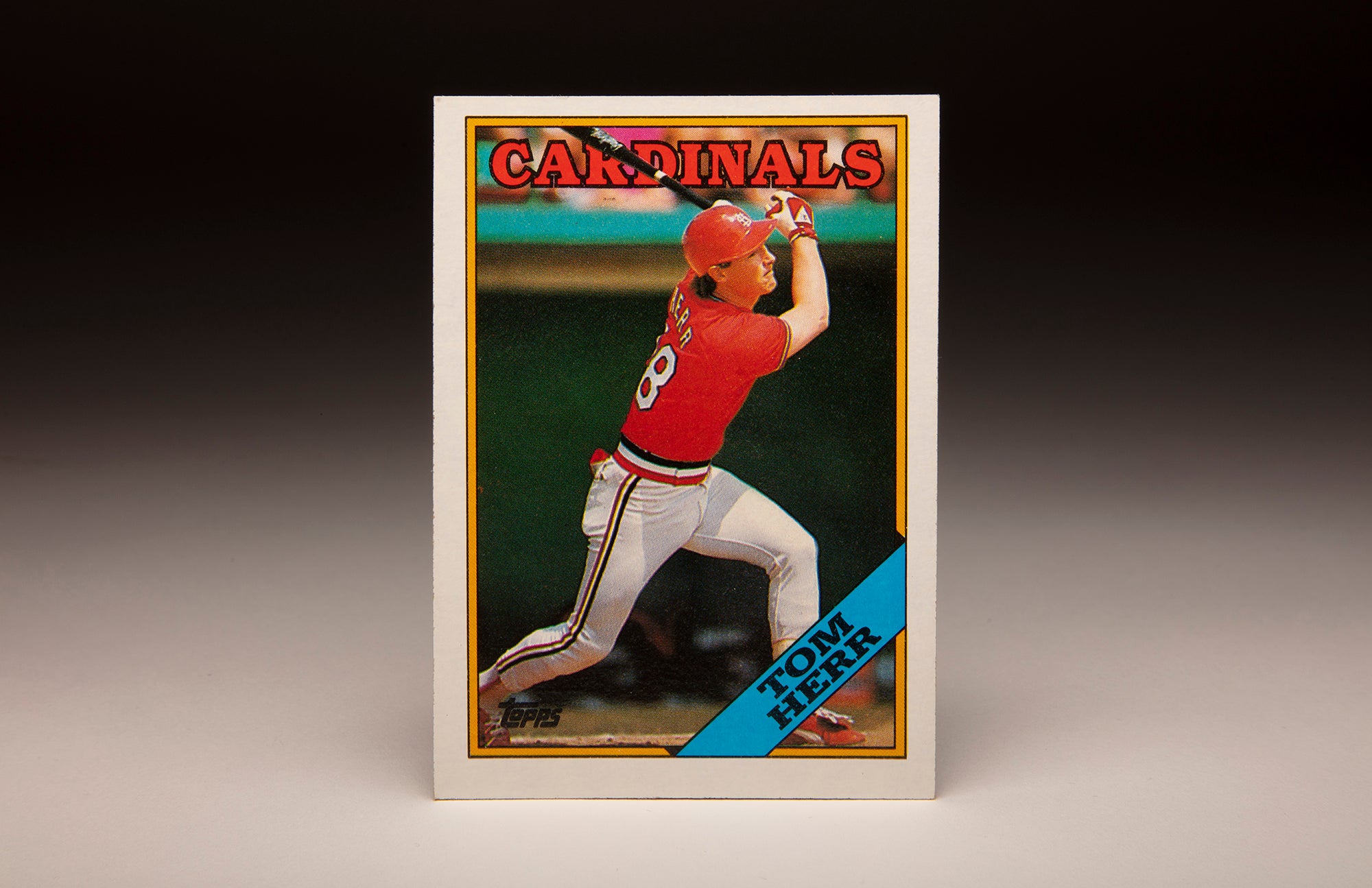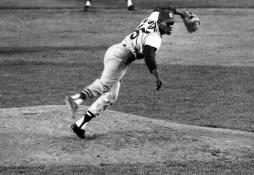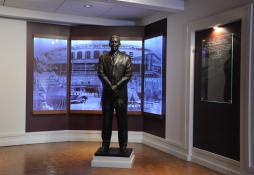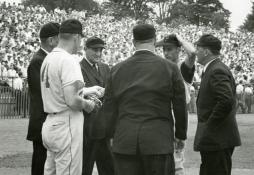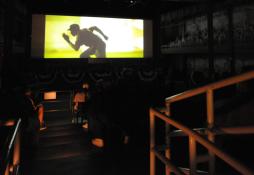#CardCorner: 1963 Topps Julián Javier
Julián Javier broke into the big leagues thanks to a trade that propelled the Pittsburgh Pirates to the 1960 World Series.
Thirteen years later, Javier appeared in his fourth World Series to cap a career that saw him become one of the best second basemen in baseball.
Cardinals Gear
Represent the all-time greats and know your purchase plays a part in preserving baseball history.
Hall of Fame Membership
There is no simpler, and more essential, way to demonstrate your support than to sign on as a Museum Member.
Born Aug. 9, 1936, in San Francisco de Macoris in the Dominican Republic, Javier grew into his 6-foot-1 frame as an amateur player – a build that made him one of the fastest athletes in the country. Pirates scout Howie Haak, who helped open the doors for talent in several Caribbean nations, signed Javier prior to the 1956 season.
“I worked (Javier) out in Santiago and gave him $400,” Haak told The Boston Globe. “I wanted to sign Felipe Alou and Cholly Naranjo, but I was told: ‘You’ll never sign anyone who (Dominican president Rafael) Trujillo wants playing for Escogido (one of the top teams in the Dominican Republic).”
Javier appeared in 18 games with Brunswick of the Class D Georgia-Florida League in 1956 then spent most of 1957 with Douglas of the Class C Arizona-Mexico League the following year. By 1958, Javier had established himself as one of the top fielding infielders in the minors, totaling a whopping 751 chances in 137 games at second base and shortstop for Class A Lincoln of the Western League. But Javier also struck out 158 times – an unusually high total for the era – while hitting .231 with 82 runs scored and 27 stolen bases.
Meanwhile, future Hall of Famer Bill Mazeroski won the first of his eight Gold Glove Awards for Pittsburgh that year – and was about one month younger than Javier.
Javier moved up to Triple-A Columbus in 1959, hitting .274 in 135 games. Then in 1960, Javier returned to Triple-A and was hitting .288 through 31 contests when the Pirates – off to a fast start – swung a trade with the Cardinals. St. Louis sent pitcher Vinegar Bend Mizell and infielder Dick Gray to Pittsburgh in exchange for pitcher Ed Bauta and Javier.
Mizell, a dependable starter in the big leagues since 1952, went 13-5 in 23 starts for Pittsburgh to help the Pirates win their first National League pennant in 33 years. Javier, meanwhile, made his debut for the Cardinals the same day as the trade and recorded two hits in three at-bats against the Giants. He would play in 119 games that season, leading the NL in sacrifice hits with 15 while batting .237 with 19 stolen bases. He finished third among NL second basemen with 338 assists.
Almost immediately, Javier became one of the most elusive second basemen in the game, seemingly able to avoid any runner while completing the double play relay to first base. In an era where baserunners were expected to take out the second baseman on those plays, Javier earned the nickname “The Phantom.”
“You have no time to think,” Javier told the Tampa Bay Times about turning the double play. “That’s why we go over there to that little diamond (in Spring Training) and work on the play for hours at a time. It must be automatic.
“You know one thing: That man on first base is going to kill you if you sit on that base.”
Javier earned the Cardinals’ starting second base job in 1961 and was hitting .293 in mid-June when a leg injury sidelined him for a month. He finished the year with a .279 batting average and 41 RBI in 113 games, once again finishing third in assists in the NL with 332.
In 1962, Javier played his first full big league season and hit .263 in 155 games, scoring 97 runs and stealing 26 bases – both of which proved to be career-bests.
In 1963, Javier again hit .263 and totaled a career-best 160 hits while leading all NL second basemen with 377 putouts. Javier was named to the All-Star Game and – when Mazeroski was unable to participate due to injury – he drew the starting assignment, as did the entire Cardinals infield of Bill White (first base), Dick Groat (shortstop) and Ken Boyer (third base).
Groat had come to the Cardinals from the Pirates via a trade following the 1962 season and had known Javier from his days in Pittsburgh.
“I’m honest when I say that I am far more impressed with him now that I’m a Cardinal than I was when I was on the other team,” Groat told the Tampa Bay Times in Spring Training of 1964. “He’s good. He makes that play back to me on the double play just great.”
Javier hit 12 homers and drove in a career-best 65 runs in 1964 as the Cardinals rallied down the stretch to catch the Phillies and win the NL pennant. But during the final week of the season, Javier suffered a bruised left hip that limited him to just one appearance as a pinch runner and defensive replacement during the World Series against the Yankees. The Cardinals won the Fall Classic in seven games with Dal Maxvill, who played in just 37 games in the regular season, starting each contest at second base.
Javier, as usual, played in the Dominican Winter League following the season and was involved in an altercation with umpire Emmett Ashford, who would go on to become the first Black umpire in AL or NL history in 1966. Javier hit Ashford after the two disagreed about balls and strikes and was initially suspended indefinitely – a penalty that was later reduced to a three-game suspension and $50 fine.
Ashford was so incensed that he resigned his post in the league.
Javier held out for a salary increase in the spring of 1965 and eventually signed a one-year contract for $25,000. He was hitting .243 on June 17 when he was hit by a pitch from Pittsburgh’s Vern Law, breaking his hand and keeping him out of the starting lineup until late August. He finished the year batting .227 in 77 games and didn’t fare much better in 1966, hitting .228 in 147 contests.
But Javier fended off a challenge from Phil Gagliano in Spring Training to make his seventh straight Opening Day start at second base. Javier went on to help the Cardinals win the NL pennant, batting .281 with 14 homers and 64 RBI. His penchant for go-ahead hits attracted notice around the league, and he finished in ninth place in the NL Most Valuable Player voting – with teammates Orlando Cepeda (first), Tim McCarver (second) and Lou Brock (seventh) ahead of him.
“Maybe I am concentrating more at the plate,” Javier told The Tennessean. “Sure, it feels great to be helping the club with my bat.”
Then in the World Series against the Red Sox, Javier fended off history in Game 2 before delivering one of the biggest hits of the season in Game 7.
After the Cardinals won Game 1 against the Red Sox, Boston’s Jim Lonborg was working on a no-hitter through 7.2 innings in Game 2 when Javier doubled to left field. It would be the only hit St. Louis would muster in a 5-0 loss. But by avoiding being no-hit, the Cardinals kept the Red Sox’s momentum from going sky high.
“Everybody was happy when I got to the dugout,” Javier told the St. Louis Post-Dispatch in 2020. “If I don’t get that base hit, I don’t think we win the next game.”
The Cardinals won Games 3 and 4 before Lonborg returned in Game 5 with a three-hitter in a 3-1 Boston win. The Red Sox then won Game 6 to set up a Game 7 showdown between Bob Gibson and Lonborg.
The difference, however, was the Gibson was working on his normal three days rest while Lonborg had only two. Javier took advantage of a tiring Lonborg in the sixth inning with a three-run homer that turned a 4-1 St. Louis lead into an insurmountable advantage.
Javier would finish the World Series batting .360 with three doubles, a homer and four RBI.
Javier once again held out in 1968, requesting $50,000 before settling for $45,000. He was named to his second All-Star Game that year and hit .260 with 25 doubles and 52 RBI as the Cardinals repeated as NL champions. Javier hit .333 in the World Series – matching his nine-hit total from the year before – but the Cardinals fell to the Tigers in seven games.
Javier stayed active in baseball in the Dominican Republic for years after his playing days, founding multiple leagues in the Dominican Republic and a Dominican Winter League team, Gigantes del Cibao, with son Stan.
Stan Javier, born Jan. 9, 1964, played 17 seasons in the big leagues and helped the Athletics win the 1989 World Series crown.
Julián, meanwhile, became such a legend in his hometown that the baseball stadium in San Francisco de Macoris is named Estadio Julián Javier.
“I liked to be a good hitter when the team needed it, especially in the World Series,” Javier told the Post-Dispatch. “Every time we had a game to win, I got the base hit to win the game.”
Craig Muder is the director of communications for the National Baseball Hall of Fame and Museum


